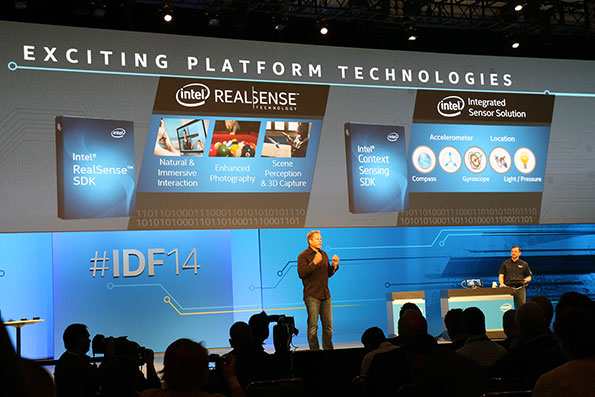Intel's Krzanich Demos RealSense Interface With Michael Dell At IDF
Let's go ahead and dispense with the inevitable shout out to Minority Report, the futuristic flick that seems an obligatory mention whenever there's talk of next-generation 3D technology. What Intel's working on is not Minority Report -- it's called RealSense, and using the technology, you can scan, modify, print, and share in 3D, as well as naturally manipulate and play with scanned 3D objects using hand and finger technology.
RealSense is an effort to move beyond the limitations of touch and tap input and to take advantage of the 3D world we live in. After all, the world isn't flat, nor should we be limited to a flat landscape on our computing devices. It's also about making devices 3D aware -- RealSense-enabled devices can perceive depth like the human eye by way of an integrated 3D depth and 2D camera.

You can also throw around the term augmented reality, which is another part of RealSense. 3D object tracking will add a new element to books and games, allowing you to interact with characters and objects in ways that weren't possible before. The real world and virtual world will blend together, which is not only fun, but could prove useful in content creation chores. Imagine designing a toy or tool and then virtually manipulating the design to look for ways you can improve it.

RealSense applications aren't expected to be broadly available until early 2015, though there's already lots of excitement and support. There are more than sixty ISVs actively developing Intel RealSense applications. In fact, Michael Dell joined Intel at IDF to showcase the technology on Dell's Venue 8 7000 Series tablet. It boasts a integrated RealSense camera, 2K resolution with Ultra HD 8.4-inch display OLED display, edge-to-edge screen, and is 6mm thin. Check it out:
In addition to Dell, several other partners are signed up to build RealSense-enabled devices, including Acer, Asus, HP, Lenovo, Fujitsu, NEC, and Toshiba. Expect to see the technology integrated into tablets, laptops, and other similar devices at first, though down the line, RealSense could expand into other categories, such as robotics.
RealSense is an effort to move beyond the limitations of touch and tap input and to take advantage of the 3D world we live in. After all, the world isn't flat, nor should we be limited to a flat landscape on our computing devices. It's also about making devices 3D aware -- RealSense-enabled devices can perceive depth like the human eye by way of an integrated 3D depth and 2D camera.

You can also throw around the term augmented reality, which is another part of RealSense. 3D object tracking will add a new element to books and games, allowing you to interact with characters and objects in ways that weren't possible before. The real world and virtual world will blend together, which is not only fun, but could prove useful in content creation chores. Imagine designing a toy or tool and then virtually manipulating the design to look for ways you can improve it.

RealSense applications aren't expected to be broadly available until early 2015, though there's already lots of excitement and support. There are more than sixty ISVs actively developing Intel RealSense applications. In fact, Michael Dell joined Intel at IDF to showcase the technology on Dell's Venue 8 7000 Series tablet. It boasts a integrated RealSense camera, 2K resolution with Ultra HD 8.4-inch display OLED display, edge-to-edge screen, and is 6mm thin. Check it out:
In addition to Dell, several other partners are signed up to build RealSense-enabled devices, including Acer, Asus, HP, Lenovo, Fujitsu, NEC, and Toshiba. Expect to see the technology integrated into tablets, laptops, and other similar devices at first, though down the line, RealSense could expand into other categories, such as robotics.

